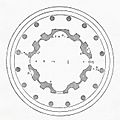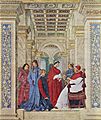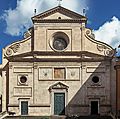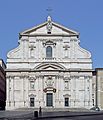Renaissance architecture facts for kids

Renaissance architecture is a style of building that was popular in Europe from the early 1300s to the early 1500s. It brought back ideas and designs from ancient Greek and Roman buildings. This style came after Gothic architecture and before Baroque architecture.
The Renaissance style first started in Florence, Italy, with Filippo Brunelleschi as a key inventor. From Florence, it quickly spread to other Italian cities. Over time, it reached France, Germany, England, Russia, and other parts of Europe.
Renaissance buildings focus on being balanced and orderly. They use ideas like symmetry (being the same on both sides) and proportion (parts fitting together well). They also use geometry and regular shapes, just like the buildings of classical antiquity, especially ancient Roman architecture. Many examples of Roman buildings still existed and were studied.
Builders used columns, pilasters (flat columns on a wall), and lintels (horizontal beams) in neat rows. They also used round arches, curved domes, niches (wall alcoves), and aedicula (small shrines). These simple, clear shapes replaced the more complex and uneven designs of medieval buildings.
Contents
Famous Renaissance Buildings
The Dome of Florence Cathedral
The Florence Cathedral, also known as "il Duomo," had a huge opening in its center. A competition was held to design a roof for it. Brunelleschi won this competition. He built the largest dome seen since Roman times. He made the whole city excited by having teams of workers from different parts of Florence help build it.
Church of San Lorenzo
This church in Florence was designed by Brunelleschi. He used everything he learned from studying the architecture of Ancient Rome. It features arches, columns, and round-topped windows, all in the Roman style. It looks very different from the pointy-arched churches of the Middle Ages. Only the inside of the church was finished. The outside is still rough brick, and no one knows exactly how it was meant to look. Inside, Brunelleschi introduced new building rules that changed architecture during the Renaissance.
Church of Sant' Andrea
When Ancient Roman Emperors won battles, they built a Triumphal Arch to celebrate. Several of these monuments are still in Rome. They usually have a large arch in the middle and smaller arches or doorways on each side. The architect Alberti used this design for the front of the Church of Sant' Andrea in Mantua. He repeated this pattern of tall arches and low, square shapes all along the inside of the church. Many other architects later copied this design.
Medici-Riccardi Palace
When building palaces, wealthy people of the Renaissance had different needs than Roman Emperors. Architects had to use the new rules to create grand new types of buildings. These Renaissance palaces are usually three stories tall and look quite plain from the outside. Inside, they have a courtyard surrounded by beautiful columns and windows. Architects like Michelozzo, who worked for Cosimo de' Medici, looked at the Roman Colosseum (a sports arena). The Colosseum is three stories high with rows of arches, which inspired the palace designs.
Saint Peter's Basilica
The most famous church in Rome was an old church built over the grave of St. Peter. By the 1500s, it was falling apart. The Pope decided to tear it down and build a brand new church. Many important artists worked on its design, including Michelangelo, Raphael, Bramante, Maderna, and Sangallo. It was the first building to use very tall columns called a "giant order." It has one of the most amazing domes in the world, and its design has been copied in many countries.
Villa Rotunda
This country house was built by Palladio in 1550. It is a square building that looks the same from every side. In the center, it has a dome. On each side, there is a large porch, called a portico, like a Greek temple. It is such an elegant design that other architects used the same style. You can see this style on churches, houses, and palaces, including the White House in the United States.
Images for kids
-
The Romanesque Florence Baptistery was the object of Brunelleschi's studies of perspective
-
Pope Sixtus IV, 1477, builder of the Sistine Chapel. Fresco by Melozzo da Forlì in the Vatican Palace.
-
Four Humanist philosophers under the patronage of the Medici: Marsilio Ficino, Cristoforo Landino, Angelo Poliziano and Demetrius Chalcondyles. Fresco by Domenico Ghirlandaio.
-
Cosimo de' Medici the Elder, head of the Medici Bank, sponsored civic building programs. Posthumous portrait by Pontormo.
-
Scuola Grande di San Marco, Venice
-
The dome of Florence Cathedral (the Basilica di Santa Maria del Fiore)
-
The Palazzo Farnese, Rome (1534–1545). Designed by Sangallo and Michelangelo.
-
The House of the Blackheads in Riga, Latvia
-
Royal Summer Palace in Prague is considered the purest Renaissance architecture outside of Italy.
-
English Renaissance: Hardwick Hall (1590–1597).
-
Cloister of the Convent of Christ, Tomar, Portugal, (1557–1591), Diogo de Torralva and Filippo Terzi.
-
The Palace of Facets on the Cathedral Square of the Moscow Kremlin.
-
The Escorial (1563–1584), Madrid
-
The large Basilica of San Francisco in Quito, built between 1535 and 1650, a UNESCO World Heritage Site city.
See also
 In Spanish: Arquitectura del Renacimiento para niños
In Spanish: Arquitectura del Renacimiento para niños











































